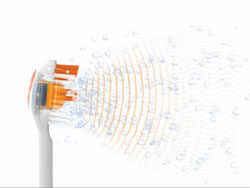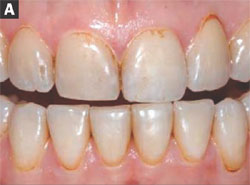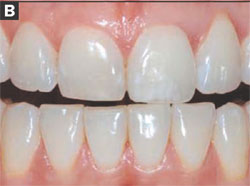The Technology Behind Ultreo and Its Technical Application
Power toothbrushes have advanced significantly since 1960 when Squibb Company first introduced the Broxodent® to the US market, but technological innovations have been limited since 1992, when the first sonic toothbrush hit the market. Now, in 2007, a completely new technology—one that has been under development for more than 3 years—has entered the market. While other power toothbrushes rely on the use of high-speed bristle motion to remove plaque bacteria physically from the teeth, Ultreo™ (by Ultreo, Redmond, WA) uses a proprietary combination of ultrasound waveguide technology and sonic bristle action that can gently remove plaque bacteria from hard-to-reach areas that bristle action alone can miss.
The technology found in Ultreo was invented at the University of Washington. In 2003, physicist Pierre Mourad met local entrepreneur Jack Gallagher. Dr. Mourad, a research scientist in the Applied Physics Laboratory’s Center for Industrial and Medical Ultrasound and a research associate professor in the Department of Neurological Surgery at the University of Washington, had an idea. He wondered if ultrasound, something he manipulated every day, could be integrated into a conventional power toothbrush. If done correctly, he hypothesized that the ultrasound energy could transform the bubbles created by sonic bristle action into pulsating bubbles that could help remove plaque bacteria from hard-to-reach places. Mr. Gallagher, the former president of Optiva Corporation (Snoqualmie, WA, the developers of the Sonicare® toothbrush*) immediately recognized an opportunity to reenergize the power toothbrush category, and together they proceeded to develop and test the concept. Today there are eight patents pending to protect Ultreo’s technology.
Early research on Ultreo was made possible by three grants from the Washington Technology Center and two grants from the National Institutes of Health (NIH). The results showed that, in a laboratory setting, a combination of precisely tuned ultrasound and sonic technology was significantly more effective at removing Streptococcus mutans bacteria than either technology in isolation.1 Additional laboratory research conducted since then supports the early research results. In one NIH-supported laboratory study conducted at the University of Washington, Ultreo was shown to remove significantly more S mutans biofilm from hydroxyapatite discs without bristle contact than the leading sonic and oscillating power toothbrush brands.1
ULTREO TECHNOLOGY
To understand the technology behind Ultreo, it is important to understand the difference between the terms sonic and ultrasound. The term sonic simply refers to a frequency between 20 Hz and 20,000 Hz that is audible to the human ear. Every power toothbrush on the market today can technically be called sonic because they have bristles that move at an audible frequency. Ultreo incorporates precisely tuned sonic bristle action as a key component of its technology. Not only do Ultreo’s bristles serve to remove plaque on direct contact, they also work to generate an optimal bubble population (Figure 1). An optimal number and size of bubbles is integral for activation by the other core component of Ultreo’s technology: ultrasound. The term ultrasound refers to the use of inaudible frequencies of 20,000 Hz or above. Ultreo pulses 4 million cycles of 323,000 Hz of ultrasound energy through a proprietary ultrasound waveguide into the waiting optimal bubble population. When ultrasound comes in contact with the bubbles, the result is thousands of active bubbles that expand and contract, able to gently remove plaque bacteria from hard-to-reach areas that bristle contact alone can leave behind.
ULTREO’S BENEFITS
Ultreo has been clinically proven to:
- remove up to 95% of plaque from hard-to-reach areas in the first minute of brushing;
- reduce gingivitis for healthier gums in 30 days; and
- remove extrinsic stain for naturally whiter teeth in 14 days (Figure 2 A, BView Figure).
Also, in a recent study:
- Nine out of 10 people who used Ultreo thought their teeth felt smooth and clean after brushing.
- Seven out of 10 people preferred Ultreo to the power toothbrush they normally use.
- More than half of the people thought the feeling of clean lasted longer than with the power toothbrush they normally use.1
AN EXPERIENCE UNLIKE ANY OTHER
Ultreo offers a brushing experience unlike any other. Patients should be advised to use the brush for at least 2 weeks to become accustomed to the way it feels in the mouth. Keep these pointers in mind when using Ultreo for the first time or instructing patients on the use of Ultreo:
- Ultreo should be used with gentle pressure and a light touch. Applying too much pressure will cause the bristles to splay, which can result in a less effective, less comfortable brushing experience.
- Keep the bristles in contact with the teeth and gumline while brushing. The rubber ultrasound waveguide located in the center of the bristles is not designed to be placed in direct contact with the teeth; its purpose is to channel the ultrasound energy from the transducer in the brush head into the bubbles created by the bristle action.
- As ultrasound requires a fluid medium to perform effectively, try to keep as much fluid around the bristles as possible while you brush.
- Ultreo has been designed to work with a small amount of toothpaste. Any type is acceptable; however, gel toothpaste is recommended.
- After 3 months of use, the ultrasound output will begin to decline. Replace your ultrasound brush head regularly to ensure optimal performance.
REFERENCES
1. Data on file. Ultreo, Redmond, WA; 2007.
* Sonicare® is a registered trademark of Philips Oral Healthcare, Inc (Stamford, CT)
DISCLAIMER
The preceding material was provided by the manufacturer. The statements and opinions contained therein are solely those of the manufacturer and not of the editors, publisher, or the Editorial Board of Inside Dentistry. The preceding is not a warranty, endorsement, or approval for the aforementioned products or services or their effectiveness, quality, or safety on the part of Inside Dentistry or AEGIS Communications. The publisher disclaims responsibility for any injury to persons or property resulting from any ideas or products referred to in the preceding material.
 | |
| Figure 1 Illustration of how the Ultreo technology works. | |
 |  |
| Figure 2 Patient with coffee, tea, and chlorhexidine- induced stain at baseline and 7 days after using Ultreo twice daily (demonstrated in a separate case study). | |



